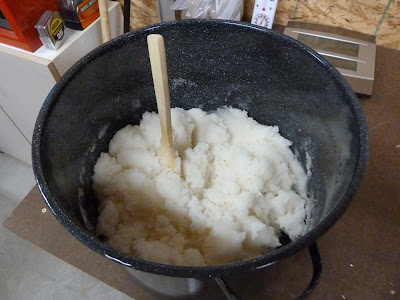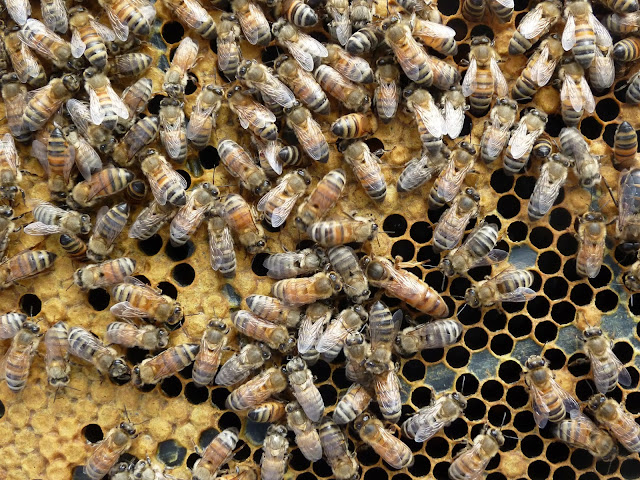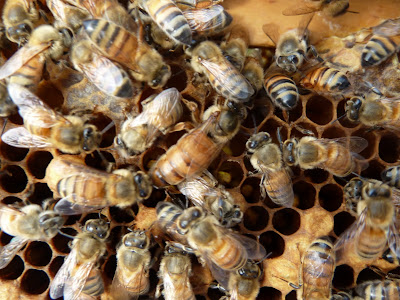Sunday was a great day to work the bees for a number of reasons. First off, my son-in-law Chris and my daughter are visiting from California and he wanted to dive into the hives with me! Second, the weather was just perfect. Temps in the 70s, clear and sunny. If any of you other beekeepers out there are anything like me (and I'm sure you are), then you love teaching others about bees. This was a great opportunity, even though I didn't expect to be able to show Chris any stages of brood development (see the last two posts). As you are about to read, this was not the case!!
Since the split and insertion of the two queen cells during my last inspection, my plan was to get in and first check to see if they have hatched. Hopefully I could spot a virgin queen running around in the process. I already know that the split hive has significantly less bees in it, as there is very little activity at the hive entrance. Because of this, I also planned on either moving a frame of bees into the split hive or just shaking them off the frames and into the split hive. With plan in place, Chris and I suited up, lit the smoker and headed out to the split hive.
Split Hive:
This was going to be a good training and teaching hive because there were not going to be a lot of bees and it would be much easier to point things out. Plus, not having a bunch of bees flying around your head is a bit less intimidating for someone's first time. We opened the hive and I was able to go through the honey super pretty quickly. There were only a few bees there and solid honey frames all look the same after seeing a few. I removed that box and started digging through the brood box, eager to get to the frame with the queen cell on it! After prying back the fourth frame, I could see the bottom of the queen cell was opened so the queen was out somewhere! We removed the queen cell and started in on the next frame and BAM there was the hatched virgin queen! I pointed her out to Chris and in the 10 seconds it took to get the camera out to grab of picture of her........she as gone. I flipped the frame over and back again a few times and she was no longer there. She must have gotten spooked and flew off. Camera shy I guess. We went through the rest of the frames and we found a bunch more honey, but I was concerned that I didn't find any stored pollen. That might be OK for the moment, but if the virgin queen does fly out and mate, comes back and starts laying eggs, there had better be some pollen in there to feed the baby bees! We put the honey super back on the hive and put the inner cover back on. I left the telescoping cover off at this point in case the queen came back she could get back in the hive a bit easier. On to White Hive.
White Hive:
We opened up this hive and there were a lot more bees here as expected. After a bit more smoke into the hive (Chris was my head smoker and picture taker) we dove in and quickly went through the honey super and set it to the side. After a bit of coaxing I was able to get the first frame out and begin the inspection. With the first few frames inspected, I was really pleased to see some pollen and "bee bread" packed into the cells.
After inspecting the next few frames, we came across a frame that had a bunch of drones and a queen cup on it.
I love spotting drones, especially when I am trying to teach someone about bees. They are easy to distinguish because their large size and big eyes stand out so much. Can you spot the drones in this picture? There is a hole close to the middle of the frame with two drones above it and a queen cup to the right.
I checked inside the queen cup just to make sure there was nothing in it, and there was nothing in there. I continued on and began checking the next frame in line. I slowed down a bit since the closer I was to the frame with the queen cell, the higher the probability that I would be able to spot the emerged virgin queen (if she was there at all). I pulled the frame with the queen cell and sure enough, she had hatched. The bottom of the cell was open and hopefully she was running around inside the hive. I proceeded to move the frame out of the way and pulled the next frame out and I find..........BROOD?!?!?! What??

At first I thought it must be all drone brood and perhaps I had laying workers but after seeing this on the next two frames and spotting a few actual drone cells, this must be worker brood. How is this possible? Well, the answer is that I screwed up. I must have missed the eggs and larvae in these frames during my last few inspections and/or I simply didn't pull the frames that had the brood on them, so I never spotted it. So now what? I would think that if there is a laying queen in this hive, that she would have instantly killed the virgin queen inside the queen cell. This wasn't the case because the virgin hatched out and was not dead inside the cell. Perhaps the laying queen didn't spot the queen cell until after the virgin hatched and they eventually found each other and fought to the death? Which one survived? By this time I am scrutinizing every inch of each frame trying to find either queen. I pull the next frame and I spot this....

If you look closely, not only are there two queen cups here, but this time they are full of royal jelly and I can spot a larvae in one of them (no doubt there is a larvae in the other one as well). What the heck is going on? If there is an existing laying queen, why were the bees trying to create a new queen? If there are larvae in these queen cups, then that means they are somewhere between 4 and 8 days old (
http://www.bushfarms.com/beesmath.htm) right around the time I placed the queen cell in this hive. Coincidence? I think I need to give Sherlock Holmes a call because I can't quite sequence the timing and all the possibilities together to form a rock solid answer to what is going on. Usually, queen cells built in the center of the frame like this are considered Supercedure cells. This means the bees have decided that the old queen is beginning to fail and they have determined to replace her. Maybe that is what was going on and my timing was just really bad? Who knows?
We finished inspecting the remaining frames and failed to spot either the old queen or the virgin queen. At this point there wasn't much left to do but close up the hive. I did take two of the frames out and after closely inspecting them (and not finding any queens), I took them over to the split hive and shook the bees into it. Hopefully that will give them a few more bees to supplement their numbers until the virgin queen mates and starts laying eggs to make new bees!
Hopefully, I will open the hive in another week and what I find will give more answers to the mystery. All in all it was a very educational inspection, not only for "newbee" Chris but for me as well!!
Thanks again for reading
 |
| Chris and Mark about to embark on an adventure! |


















































